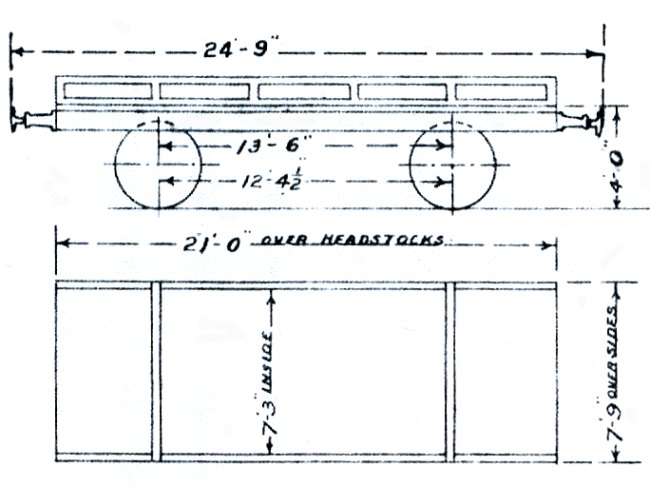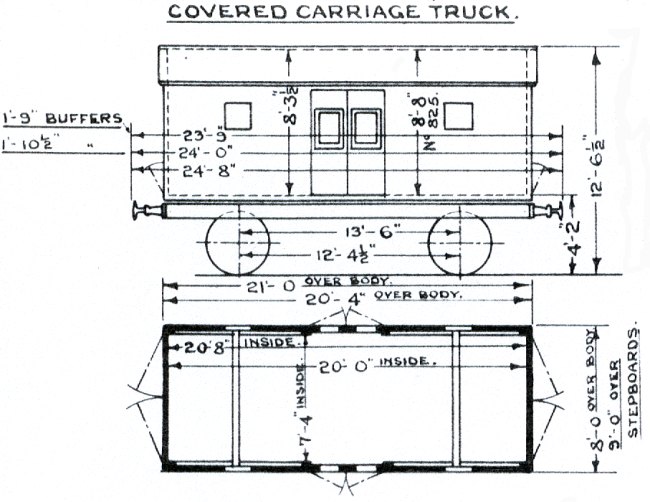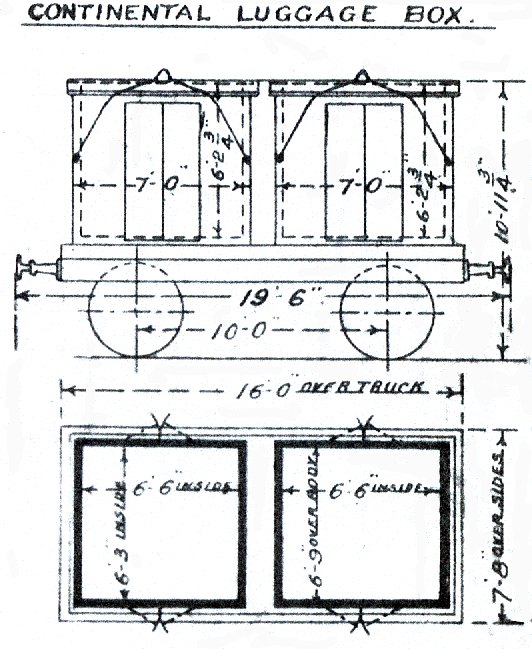Carriage Trucks – Diagrams 1 to 14, 39, 47 and 50

As a type they went back to the very beginnings of the ECR, a small number being available on its opening day in 1839 for the conveyance of private horse drawn road carriages. They provided an ideal means of travel, much faster and comfortable than by road, the occupants insulated from the appalling possibility of encountering inferior persons travelling in the same train.
The practice of allowing owners to travel in this way, as distinct from carrying their carriages by rail while occupying a first class compartment in the same train, probably died out quite quickly. However, it is a fact that as late as 1920 the GER still offered to convey invalids and their attendants in its invalid road carriage loaded onto an open carriage truck stationed at Stratford for the purpose.
The basic design of truck varied little over the years; it was essentially a flat floored truck with drop plates at either end to allow vehicles to be wheeled on and off an end loading dock. Low, hinged sides had perforated iron strips fitted on the inside to support a pair of adjustable transverse wheel bars. Rails fitted on the sides provided a fixing for the leather straps used to hold the vehicle steady. The body did not have any fixed or hinged ends.
Late ECR and early GER trucks were 16ft long with open framed sides but by the mid 1870’s the sides were solid hinged planks about 12ins deep. This basic design continued to be built until 1893, to a total of 145 trucks and although covered by 4 diagrams, nos 1, 2, 3 and 4, there were only minute differences between them. In 1896 10 trucks to diagram 6 appeared having for the first time steel frames and a reversion to open framing for the sides and to an increased length of 20ft 3ins. The next order for 10 trucks built in 1900 to diagram 5 saw the length reverting to the familiar 16ft but retaining steel frames and open framed sides. A further variation occurred in 1903 in an order for 10 trucks to diagram 7 to the modified length of 21ft but otherwise closely resembling the diagram 5 stock. Another 30 examples were constructed in 1912, probably in response to increasing military traffic, followed after the war in 1920 by the last new order for a batch of 5 trucks to diagram 50; effectively a wider version of diagram 7 stock.
The final additions to stock were two open bogie trucks intended for theatrical traffic, both to diagram 47 although there were differences in their length and detailed construction. The first was 47ft 8ins long and was a reclaimed underframe from a first class dining carriage destroyed in an air raid on Liverpool Street in 1917. In 1920 it was provided with a flat floor and low curb rails and a plentiful supply of rope eyes. The second truck was 49ft 5ins and had initially been one of four flat wagons fitted up to carry aeroplane parts but this example was transferred to the miscellaneous stock with minimal alteration apart from the provision of power brakes.

All the types so far described were open trucks but a modest number of covered vehicles were also built to convey the more valuable road vehicles. The first 2 were built during 1878 and 1879 and had bodies16ft long with high elliptical roofs, to diagram 8. The ends had a full width bottom flap for loading vehicles, in place of separate drop plates, with double doors above extending to the full height of the body. A small sliding door centrally placed in each side gave access for inspection en route. Like the open trucks, adjustable wheel bars were provided and a sliding bracket for carrying lashing straps to secure the load.
No further covered trucks appeared until 1890 when a completely new design appeared to diagram 9. The body now had a pair of full height side doors, slightly increased headroom and was mounted on a steel underframe with bulb angle solebars. Ten trucks were built followed by a single example in the following year with a body 2 feet longer overall. The longer truck was provided for the exclusive use of Wood & Sons, St Ives, who were carriage builders, for which the firm paid £ 8 per annum for its exclusive use, over and above the ordinary rates and enjoyed the privilege of having ‘their name and address being painted on in bold letters on the sides of the truck’.
The remaining covered trucks although built to two different lengths were unusually included under the single diagram 10. The first order placed in 1895 was for 5 steel framed trucks 20ft 4ins long, with bulb angle solebars, repeated in next order for 10 trucks delivered in 1897. Further trucks completed in 1902 had steel frames with channel solebars, reflecting the decision to use that section on all future steel framed rolling stock. The final order of 5 trucks delivered during 1912 were to the increased length of 21ft, having the same channel steel underframe as the diagram 7 open carriage trucks built from 1903 onwards.
Although classified in the rolling stock returns as a general van a final type of covered carriage van with 6 wheels, to diagram 39, was introduced in 1910. As the first examples were lettered as carriage vans they will be described here. Its length was 31ft 4 ½ ins and in terms of body construction and profile was the same as the diagram 40 milk van being constructed at the same time. Inside it was equipped two sets of wheel bars and securing straps with double doors and drop flaps in each end for loading wheeled vehicles. Three pairs of side double doors were fitted, with louvres in the upper part of the body and four small windows of which the outer ones had droplights. In design they were quite utilitarian, marking an end to any attempt to make the stock compatible with the appearance of passenger carrying vehicles.
Five were built early in 1910 and lettered as carriage vans but this was not repeated in the remaining orders for 10 and 20 vans both delivered in 1912. By now the running number series had rather disintegrated and although since 1897 every miscellaneous vehicle now had a unique number, it is rather odd that these vans were numbered to follow on from the last of the yeast vans built in 1893. The vans were gave good service and most saw lasted into the mid 1950’s.
As a result of the purchase of two independent railways three conventional open carriage trucks also came into GER hands. The first was a single example from the Felixstowe Railway in 1879, to the same design as diagram 1, and a pair from the Thetford & Watton in 1880, having a length of 15ft and open framed sides a design more in common with late ECR stock than any GER product.
Having reviewed the purpose built open and covered carriage trucks there were several converted vehicles included in the carriage trucks totals; curiously they were all distinguished by the fact that none were capable of conveying road vehicles. The earliest to be noted was a weighted truck converted from a pre1865 open carriage truck, its purpose is unknown to me but as the flat body was fitted with hand rails around the periphery it was probably used for inspection purposes. In 1875 a diagram 1 vehicle was appropriated by the Engineer as a guard truck for his saloon, this had low sides added, with a side access door, and double doors in each end, possibly to assist in loading equipment. It was probably used for inspecting bridges and other line side equipment. It was replaced in 1908 by a six wheeled truck, diagram 12, being the carriage underframe from one of the victims of the Witham crash in 1905. A new body was built, essentially a flat truck with 3ft deep fixed sides with two access doors and a pair of full width inward opening end doors and a hinged seat on either side.
In 1879 the GER saw a market in selling sea water in London and bulk deliveries were made from Lowestoft in saltwater tank wagons. The first examples were created by mounting rectangular water tanks on a pair of diagram 1 open carriage trucks. These were evidently a success as another 8 tanks were provided in the following year, but this time converted from open fish trucks, which will be described below. Interest in bathing in sea water had waned by the end of the century, perhaps it was being seen as a rather dubious fad in the face of the general improvement in the supply and purity of domestic water, so the tanks were removed and all 10 trucks reverted to their original purpose.

During the 1890’s Continental traffic via Parkeston Quay was steadily growing and the trains from London included several vans to cope with an increasing amount of luggage. To deal with this more effectively, and to reduce handling at the quayside, a portable luggage box (the forerunner to the modern container) was devised which was loaded at Liverpool Street and transferred direct by crane from a continental luggage box truck into the hold of the steamer. The truck was designed to carry two boxes each measuring 11ft 6ins long and 6ft 9ins wide and was attached to the continental train. The first one was built in 1894, to diagram 14, length 26ft and with a wooden underframe. In design it was exactly the same as an open carriage truck but without the adjustable wheel bars and equipped with securing chains; a second truck was constructed in 1897. Two further trucks were provided for this traffic but this time more economically by the conversion of a pair of diagram 1 open carriage trucks on which two 7ft long boxes were loaded.
During the 19th century carriage trucks were generally used to convey road carriages, for delivery and distribution from the makers and by owners who wished to have their own conveyance when on holiday. They could carry loads of up to 5 tons and besides being more than adequate for the road vehicle of the period were extensively used for scenery, furniture vans and light agricultural machinery.
Their use for military traffic increased at the beginning of the 20th century and it was the practice to load light guns and army vehicles for conveyance to manoeuvres, in trains including horse boxes and a carriage or two for officers and other ranks. Covered trucks were always in the minority, never exceeding 16% of the total and reserved for the better class carriages and other valuable vehicles.
After Grouping the LNER did not find it necessary to add to their stock of open carriage trucks, more than enough had been inherited from the constituent companies and for motor vehicles the preference was to use covered vans. In the early 1930’s some open trucks had a new lease of life with the introduction of containers and although to a large extent an obsolete concept by Grouping several lasted in traffic until the end of the 1950’s.
